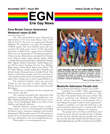Behind the Lens: Photojournalist Kay Lahusen
By Tracy Baim
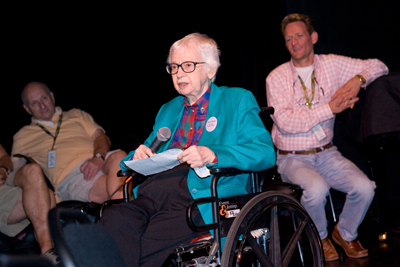
Kay Tobin Lahusen was the first photojournalist of the LGBTQ movement, a pre- and post-Stonewall activist who helped to document the earliest protests for homosexual rights.
Lahusen, born Jan. 5, 1930, in Cincinnati, is perhaps best known as the life partner of activist Barbara Gittings, but she was an equal partner in their 46-year relationship, begun in 1961, and lasting until Gittings' death in 2007.
The women met in Rhode Island at a party for The Ladder, a national publication of the lesbian group Daughters of Bilitis (DOB). This was fitting, as they would later work on the publication together, from 1963 until the summer of 1966. A Lahusen photograph, under the name Kay Tobin, was the first photo of a real-life lesbian to appear on the cover of a homosexual publication, in September 1964. The first full-face portrait of a lesbian on the cover was in January 1966, of D.C. activist Lilli Vincenz.
Lahusen spoke about her early life with Eric Marcus, for his book "Making Gay History: The Half-Century Fight for Lesbian and Gay Equal Rights": "The summer after I graduated, in 1948, I met a girl who had gone to the same high school I had. We hadn't met before. I fell in love with her … [A]fter a year together, I finally faced the fact that this was more than friendship. This was desire and sex and lust and love, just like straight people feel. I have to tell you, I had a breakdown over this revelation … This went on for two weeks … I finally brought it to a head within myself; I just decided that I was right and the world was wrong and that there couldn't be anything wrong with this kind of love."
Lahusen moved to Boston to work for The Christian Science Monitor in the reference library, from 1956-61.
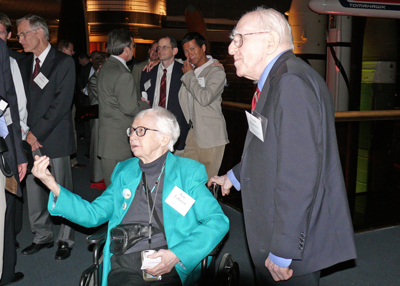
She found out about The Ladder from a psychiatrist in New York City.
"In doing my research at the Monitor, I found a book called 'Voyage From Lesbos: The Psychoanalysis of a Female Homosexual,' written by a psychiatrist named Richard Robertiello," Lahusen told Marcus. "In the book, Robertiello focused on a lesbian he had treated - and believed - cured. He was a well-known psychoanalyst at the time. So in 1961, I made an appointment with him in New York. I asked him a couple of questions about what made people gay, which I wasn't really interested in. Then I came to the real question, 'How do I meet others?' So he said, 'Oh, if that's what you want, that's easy.' He reached over on his desk and pulled out this old copy of The Ladder and gave it to me. He said, 'Here. This is published by the Daughters of Bilitis. They have an office here in New York. You can call them up. Here's the phone number.' Well, I almost fell off the chair. I said, 'That's enough,' and even though I only spent 10 minutes with him, I wrote him my check for $20 for the full hour. I was lifted to the skies, but I was so thrown I couldn't even think of contacting DOB that minute. I had to regroup."
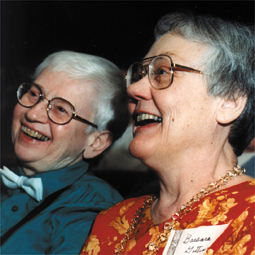
Lahusen soon met Gittings, and quickly became immersed in the world of homosexual activism and publishing.
"After a brief courtship, we settled into her efficiency apartment in Philadelphia. We've been together in the gay cause ever since," Lahusen wrote in Vern Bullough's book, "Homosexuality: A History."
"Although Kay's name didn't appear on the masthead, her vision, as much as mine, shaped the magazine for three and a half years," Gittings told Troy Perry and Thomas Swicegood in their book "Profiles in Gay & Lesbian Courage."
"Kay and I believed we could eventually reach tens of thousands of lesbians who had never heard about our movement, lesbians who didn't necessarily want to join us but needed to see themselves in a better light, who needed to know that they were not alone, that something was being done to change things," Gittings said.
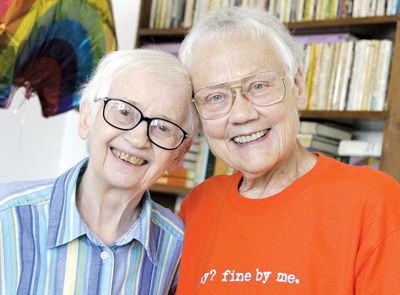
When Time magazine published an essay, "The Homosexual in America," on Jan. 21, 1966, referring to homosexuality as "a pernicious sickness," Lahusen responded in the April Ladder with "A Rebuke for TIME's Pernicious Prejudice," followed by "Letters TIME didn't print," criticizing the "crippling methodological flaws [in the Time article]."
The first White House picket for homosexual rights happened April 17, 1965. That year proved to be a pivotal one nationally for gays protesting in the streets.
The April 17 protest was against Fidel Castro's plan to put Cuban homosexuals in labor camps, and it also aimed to call attention to the poor treatment of homosexuals by the U.S. government. There were 10 picketers that day, and 29 at activist Randy Wicker's United Nations protest April 18. Another White House protest followed, on May 29, with about 13 people (signs included "We Don't Dodge the Draft, the Draft Dodges Us"). On June 26, more than 20 protested in front of the U.S. Civil Service Commission over its ban on the employment of gays.
The July-August 1965 edition of The Ladder covered the protests, as reported by Lahusen:
"After all efforts to negotiate with the Commission had failed, the homosexuals decided to stage a public demonstration and call attention to the problem … All were conservatively dressed and presented dignified appearance."
On July 31, there were 16 picketers at the Pentagon over military antigay bias. On Aug. 28, there were 14 reported at the State Department to protest employment bias and security-clearance issues. On Sept. 26, a total of 30 picketed at San Francisco's Grace Cathedral to protest discrimination against a pro-gay minister. And on Oct. 23 of that year, 45 people picketed at the White House.
A press release for the Oct. 23 picket stated four targets of the event: exclusion of homosexuals from federal employment; the military ban on homosexuals; denial of security clearances to homosexuals; and the "continuing refusal, by the White House and other agencies of the Federal Government, to accord even the common courtesy and decency of replying to letters written on behalf of the homosexual community … "
Gittings was at nearly all of those protests, and Lahusen was there to document.
"Kay's grandfather died, and we came back [from Ohio] in time to take part in all the summer demonstrations that year," Gittings told Marcus. "We were at the first protest at the White House and the first one at the Pentagon."
Also in 1965, on July 4, a series of annual protests began at Independence Hall in Philadelphia that would further shape Gittings' role as a leader in the movement. These protests were, after all, in her adopted hometown, one that in later years would honor her with street dedications, awards and special tributes. Lahusen made sure these events were documented, and not forgotten.
The West Coast leadership of DOB became concerned about the more activist direction of The Ladder, so Gittings and Lahusen were out by 1966.
But by then, Gittings and Lahusen climbed onto a larger platform, with Lahusen documenting their efforts every step of the way.
Gittings and Lahusen were not in New York City when the Stonewall riots occurred, but when they returned from vacation, they kept pace with the swift changes in the movement by joining protests and new organizations.
"I don't like violence but I was pretty elated to hear that GLBT people were standing up and fighting back in the midst of a police [raid] on a seedy, Mafia-run gay bar," Lahusen said in a 2012 Philadelphia Gay News interview with Jen Colletta. "Gay people were largely outwitting the police. News of their bravery galvanized gay people in New York and across the country really. The riots were a flashpoint, Barbara used to say, in the gay-rights movement and inspired gay people to get further organized and step up their efforts to improve the lives of their minority … Early picketers inspired gay people to go a step further and fight back at Stonewall."
"When we came back into the city that September, I immediately started attending the meetings of a new organization called the Gay Liberation Front," Lahusen told Marcus. "They were huge meetings. It was the best theater in town. This was the heyday of radical chic. These people were out there in million-dollar rags, each more far out than thou in terms of their leftist ideology. They were spouting stuff that I had never heard before. And here I was, the plain-Jane dinosaur out of the old gay movement."
Lahusen recalled that she and Gittings tried to turn a negative - being called "dinosaurs" by their own community - into positive public relations. The couple would often bring two stuffed dinosaurs to community meetings and events, and their photo was taken with the props.
Gittings, Lahusen and other Philadelphia activists turned their focus in 1970 to the first-anniversary commemoration of the Stonewall riots, with some 2,000 people attending the Christopher Street Liberation Day march in New York City.
Lahusen was one of the original dozen-or-so members of the Gay Activists Alliance, which was seen as a single-issue group. "We didn't want somebody telling us we had to go out and picket for all these other causes," she told Marcus. "We also wanted a structured group. GLF was always chaotic. The GLF people, of course, said they had no leaders. That was part of their thing. We didn't want chaos. We wanted a structured group. So we decided on Robert's Rules of Order. We decided to have officers, elections and all those standard things. GAA was almost totally political. Politics was everything. You had to have your meetings with the police, to put the squeeze on. Organize gays as a voting bloc. That was GAA's big thing."
Lahusen also organized the Gay Women's Alternative in the early 1970s in New York City.
"[GAA] did all sorts of public protests," Lahusen told Marcus. "We lay in wait for Mayor Lindsay to come out from the Metropolitan Museum and then stormed up the steps and got right in front of him and asked him embarrassing things. When the U.S. ambassador to the United Nations came out of some meeting and got in his big black limousine, I remember going crazy, rocking and beating on the limousine. He didn't know what was going on. He had never been besieged by a bunch of homosexuals before."
Lahusen also wrote and took photos for New York's GAY newspaper in the early 1970s. GAY was edited by Jack Nichols and his partner Lige Clarke.
"We did plenty of things, and I covered it all for the GAY newspaper," she told Marcus. "I was interviewing and writing news stories and taking pictures. I would confront politicians and say, 'I'm with GAY newspaper. Where do you stand on … ?' I would dutifully write down their answers. I would even tape their answers, so I would be dead-accurate. It was a very exciting time."
Gittings, Lahusen and Frank Kameny also took on the antigay policies and culture of the American Psychiatric Association together. In advance of their appearance on a 1972 APA Dallas conference panel that would become historic, Gittings and Kameny issued "Gay, Proud, and Healthy," a statement regarding the psychiatric profession. Lahusen said of the panel: "This isn't right. Here you have two psychiatrists pitted against two gays and what you really need is someone who is both." The panel moderator, Dr. Kent Robinson, agreed to add a gay psychiatrist if the activists could find one. "Kay and I wrote letters and made phone calls around the country," Gittings recalled years later in summarizing her work fighting the APA. "At last, John Fryer said yes, provided he could wear a wig and mask and use a voice-distorting microphone. Dr. H. Anonymous was born."
Lahusen's photos of that panel provide critical documentation of the successful effort to change the APA.
Also in 1972, Lahusen published the book "The Gay Crusaders." The publisher insisted on having a male name with hers on the cover, so Randy Wicker agreed, but he said it was all Lahusen's effort.
Lahusen also joined Gittings in her fight to change the homophobia permeating the American Library Association. The Task Force on Gay Liberation sponsored a kissing booth in the exhibit hall at the 1971 ALA conference in Dallas. Changing the approach of libraries was a critical move on the part of activists, as these were often the first places LGBT people could find information about their lives - for good or bad.
Of those early protests, Lahusen told PGN's Colletta: "Some participants were fearful, some were proud, others were simply marching in the belief that they had to come out if things were going to change. It's been said that all social-change movements find they ultimately have to take to the streets. Think of the early suffragettes, for example. Of course, when you're marching, you have no crystal ball to tell if you're helping make changes but you hope so, even believe so. I certainly believed we were doing something historically significant, something to help lift GLBT people as a class in our society."
There is a bench that marks Gittings' final resting place, in Washington's Congressional Cemetery. "This is where we will be buried together, our ashes will be together in this bench," Lahusen said.
On the top it reads "GAY PIONEERS who spoke truth to power. GAY IS GOOD."
The front of the bench reads: "Partners in life. Married in our hearts."
This article is excerpted and adapted from "Barbara Gittings: Gay Pioneer," a 2015 book by Tracy Baim.



